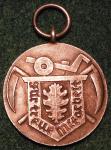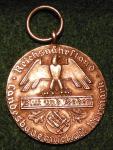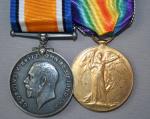-
Posts
520 -
Joined
-
Last visited
Content Type
Profiles
Forums
Blogs
Gallery
Events
Store
Everything posted by censlenov
-
Hello Just picked up this "Antique Victorian Religious Medal" off eBay. The order looks good to my eye but i know very little about such things. I will say the suspension loop appears to be hallmarked and the suspension ring as well although all i can make out is a 6. The also appears to be 2 hallmarks on the revers top and bottom arm which i have a hard time making out. I'll work on getting some nice close ups posted soon. What do you all think? Cheers Chris
-

Interesting Surplus store find
censlenov replied to censlenov's topic in State, Civil Awards & Decorations
Thanks for all this info gents especially the proper name. When i typed that into a search engine i found several others to compare to. Cheers Chris -
Found the attached medal in a surplus store in lethbridge today. Can anyone tell me if this is perhaps a "real" medal as opposed to a fantasy piece? Hard to tell from the photo's but it is silver. If it is a real medal can anyone tell me what it is and give me a bit of background on it. Cheers Chris
-

Belgium Some new medals
censlenov replied to Laurence Strong's topic in Northern European & Baltic States
Great finds Larry were these from the gent who was selling French medals in bulk? I thought it was a great show and got a few nice pieces and came home with way more cash than i arrived with. I look forward to next years show. Cheers Chris -
Thanks for all the great comments gents. I was quite surprised when all this was listed in a single lot. It's my hope by selling the "rejects" i'll be able to make back my outlay and keep the rest in the collection. The RNWMP tunic didnt come with the sam browne but i'm sure i have an early ww1 sam browne that would look great on it in the storage room at home. There is a big show the Easter long weekend that i will be taking some of the "rejects" to in hopes of making some trades/cash. Otherwise i hope to sell on the forum or privately and avoid ebay at all cost. Cheers Chris
-
No.6 A real gem in this lot a complete ww2 RAF officers uniform. What makes this uniform very very rare is that it is badged to an Eagle Squadron Pilot. There was only 244 pilots in the Eagle squadrons who would have worn these patches and these uniforms seldom come onto the market. The cap is named to a Pilot Officer Care. Prelim research pulls up one Eagle squadron pilot with that last name. Raymond C Care flew with 71 Squadron 1941-43and was transfered to the USAAF in 1943. In 1944 he was shot down by flak and taken POW. By that time he had 6 confirmed kills and one probable.
-

What is a fair price for a different variety of US medals?
censlenov replied to MCPJSmits's topic in United States of America
I'll jump in and suggest that a realistic price you could expect to get would be around the $120-150 range. These modern cased sets are really common and i can get them for between $30-50 dollars at local gunshows. Cheers Chris -

1907 Lee Enfield - Again .............
censlenov replied to Mervyn Mitton's topic in Swords & Edged Weapons
I was quite lucky when i purchase my SMLE back in 2002 i paid $150 for it 1918 dated with full wood a nice little shooter. I bought a nice decent repro uniform from a film company in Calgary for $80 came with tunic, pants, boots, and helmet. They were clearing out there warehouse about 2 years ago. Makes a nice display. Cheers Chris -

Some CEF Groups in my collection
censlenov replied to censlenov's topic in Great Britain: Orders, Gallantry, Campaign Medals
466206 Pte. Arthur Thomas Trotman 63rd/10th Canadian Infantry Battalion CEF In the spring of 1915 Medicine Hat was in the process of preparing to recruit its own infantry battalion to add to the pool of men traveling over the Atlantic and trudging into the trenches in France. A battalion of mounted rifles had just left the City in June when a request for recruits came from Edmonton. The 63rd Infantry Battalion Headquartered in Edmonton was having trouble filling its ranks and needed more men. The job fell to the recruiters in Medicine Hat to fill “D” Company of the 63rd and it was a job they did well. On July 2nd 1915 Arthur Thomas Trotman entered the recruiting office and attested for service in the Canadian Expeditionary Force. Trotman was not born in Canada he was from Bisley Glouchestershire in England birthed on September 11th 1884. He immigrated to Canada and first was recorded living in Medicine Hat in 1911. Arthur lived in a suite at 341 3rd Street SE by himself and worked as a general labourer for a Mr. B Roberts. His medical examination at the time of his enlistment describes him as 5’ 7 ½” tall, of a medium build, with a medium complexion, Blue eyes, and Dark Brown hair. When the ranks of “D” Company filled and the Battalion had undergone some initial training in Canada Arthur proceeded east to the disembarkation port of St. John New Brunswick where he hunkered down aboard the SS Metagama for the journey to England. The ship left port on April 22nd 1916 and arrived in England on the 5th of May. In England the 63rd proceeded to Shorncliffe where the battalion was disbanded and its troops were placed into the 11th Reserve Battalion on June 4th. By June 6th Trotman was assigned to the 10th Infantry Battalion and on the 8th he had arrived in France and proceeded to join his new unit. The Battle of Mount Sorrel had just taken place on June 3rd. It was another unsuccessful assault; the counter-attack by the 10th was launched against a small knoll in the Ypres. There were considerable losses suffered and despite the relatively low height of this feature, it provided an excellent viewpoint over flat terrain in the area and was of considerable strategic importance. The 10th would not see another major action until near the end of the Somme campaign. The 10th Battalion was involved in a series of operations from 8 September and 17 October, primarily defensive actions which were successful, north of Albert, France near the town of Boiselle. A successful defensive battle fought by the 10th Battalion, during the Somme Campaign, near the town of Albert, France was “Ancre Heights”. Modest casualties were suffered during the action on 10–11 September 1916. On 26 September 1916 an action took place at the Thiepval Ridge, near the town of Courcelette. The offensive operation was considered a success for the 10th Battalion, at the cost of 241 casualties. One of the wounded during the Thiepval Ridge battle was Arthur Trotman he had been shot in the left arm. After receiving preliminary treatment in France he was taken back to England for additional treatment and recuperation. After his arrival in England he was first transferred to Canadian Casualty Assembly Center (CCAC) Fokestone on October 2nd and from there was sent to Bagthorpe Military Hospital in Nottingham. Following a two month stay he was transferred to Canadian Convalescent Hospital (CCH) Hillingdon in the township of Uxbridge on the 14th of December. On the 13th of February 1917 after completion of his convalescence Arthur Trotman was assigned to Garrison Duty Depot (GDD) Hastings. His wound had left him unacceptable for front line service but still able enough to perform more menial tasks. A little over two weeks later on the 28th he was assigned to 33 Company 3rd District Canadian Forestry Corps. The Canadian Forestry Corps (CFC) was created on the 14th of November 1916. It was discovered that huge quantities of wood were needed for use on theWestern Front. Wood was used to build duckboards, shoring timbers, crates, etc. The British government concluded that there was nobody more experienced or qualified in the British Empire to harvest timber than the Canadians. At first the idea was to harvest the trees from Canada's abundant forests and bring them overseas. However, space aboard merchant ships was at a premium and so rather than stuff ships' holds with timber; it was decided to use the Canadians over in Europe to cut down forests in the UK and France. Arthur continued to serve in the CFC and on July 2nd he was awarded a good conduct badge. He was transferred to the 4th district in September and the 5th district in November. Following the end of hostilities Trotman was transferred to the CFC depot on November 23rd 1918. From there he proceeded to Canadian Discharge Depot (CDD) Buxton on December 4th. By the 15th of December he was on his way back to Canada. Arthur Thomas Trotman was officially discharged at Calgary on February 14th 1919. Not much else can be found out about Arthur Trotman after the war only that he lived to be 98 years old. He died at Shaughnessy Hospital, Vancouver, British Columbia on February 23, 1983. For his service in the war he was awarded the British War Medal 14-18 and Inter-allied Victory Medal.






